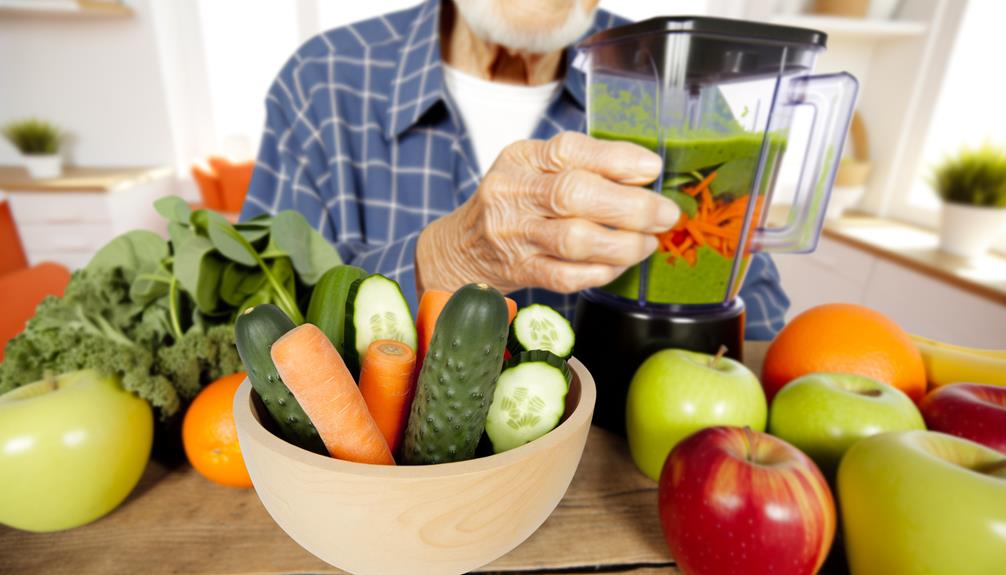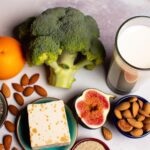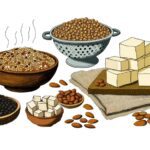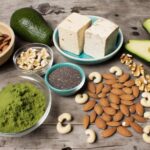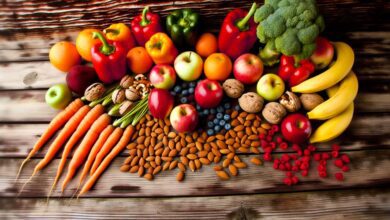Have you ever considered how a raw food diet might transform your golden years? As you age, maintaining a balanced and nutritious diet is crucial, and embracing a raw food lifestyle could be a game-changer for your health. You’re probably aware that plant-based diets are lauded for their numerous health benefits, but it’s essential to navigate this dietary change wisely, especially as a senior. You’ll need to ensure you’re getting all the necessary nutrients to keep your body in top form. From keeping your bones strong with adequate calcium intake to staying hydrated and incorporating sufficient protein sources, there are several key considerations that can’t be overlooked. While the thought of transitioning to raw foods might seem daunting, don’t worry—you’re not alone. As we explore these 13 essential tips, you’ll discover how to adapt to this lifestyle in ways that are both fulfilling and aligned with your body’s changing needs. What’s next could very well redefine your approach to wellness, and it’s just around the corner.
Key Takeaways
- Evaluate nutritional requirements and seek guidance from a healthcare professional or dietitian familiar with plant-based nutrition to ensure that all necessary vitamins, minerals, and protein needs are met while following a raw food diet.
- Stay hydrated by drinking plenty of water and including hydrating fruits and vegetables in meals, while avoiding excessive caffeine and alcohol.
- Incorporate calcium-rich foods like leafy greens, almonds, and chia seeds, and explore plant-based milk alternatives fortified with calcium to maintain strong bones and overall health.
- Incorporate healthy fats like avocados, nuts, and seeds for optimal nutrition and energy, while practicing portion management to maintain a balanced raw food diet and support weight loss and overall wellness.
Assess Nutritional Needs
Evaluating your nutritional requirements is crucial when adopting a raw food diet, especially as a senior with specific health needs. As you age, maintaining muscle mass becomes a significant concern. A well-planned raw food diet, rich in plant-based proteins from nuts, seeds, and sprouted legumes, can help support your musculature. Remember, older adults may require more protein than their younger counterparts to sustain muscle health.
It’s essential to be conscious of the vitamins and minerals that support your well-being. Calcium and vitamin D are vital for bone health, while B12 is critical, especially in a plant-based diet, to prevent deficiencies. You might need to consider fortified foods or supplements for these nutrients, as they are less available in raw plant foods.
You’re not just feeding yourself; you’re serving your body’s needs and, in turn, serving your community by embracing a lifestyle that is sustainable and compassionate. A diverse array of colorful fruits and vegetables will ensure a broad spectrum of antioxidants and phytonutrients, promoting overall vitality.
Keep in mind that hydration is just as important, so drink plenty of water. Seek guidance from a healthcare professional or a dietitian familiar with plant-based nutrition to tailor your diet to your unique health profile.
Prioritize Hydration
Staying well-hydrated is essential on a raw food diet, so it’s important to drink plenty of water and include hydrating fruits and vegetables in your meals. You’re not just nourishing your body with enzymes and nutrients but also ensuring that every cell stays refreshed and active. Carry a reusable water bottle, and don’t hesitate to set reminders to drink water throughout your day. Remember, your commitment to a raw food diet is a testament to your dedication to caring for yourself and others by choosing a sustainable and healthful lifestyle.
Mindful of your hydration, avoid excessive caffeine and alcohol, as they can leave you dehydrated. Instead, focus on the abundance of moisture-rich fruits and vegetables that nature offers. Monitor your urine color and frequency; aim for pale yellow and regular bathroom trips—a clear sign you’re hydrating properly.
Below is a table of hydrating foods to incorporate into your raw food diet:
| Hydrating Foods | Benefits | Tips |
|---|---|---|
| Cucumbers | High water content | Add to salads |
| Watermelon | Refreshing & juicy | Enjoy as a snack |
| Leafy Greens | Rich in minerals | Include in smoothies |
| Citrus Fruits | Vitamin C boost | Squeeze into water |
| Berries | Antioxidants | Mix into fruit salads |
Include these in your daily meals and you’ll support your hydration needs while relishing the flavors of a plant-based life.
Focus on Calcium Intake
To maintain strong bones and overall health on your raw food journey, it’s crucial to focus on foods that are rich in calcium. As you embrace a raw food diet, it’s important to ensure you’re getting essential vitamins and minerals, especially as a senior with changing nutritional needs. Leafy greens like kale and bok choy are not only vibrant and flavorful but are also packed with the calcium your body requires.
Incorporating a handful of almonds or sprinkling chia and sesame seeds onto your salads can significantly boost your calcium intake. They’re easy to enjoy and offer a satisfying crunch to your meals. When you’re in the mood for something sweet, reach for calcium-rich fruits such as oranges and figs, which support your calcium levels deliciously.
Don’t overlook the power of plant-based milk alternatives; many are fortified with calcium and can easily complement your diet. Vegetables like broccoli also play a starring role in meeting your calcium needs. For an extra nutritional punch, explore superfoods like spirulina. Its concentrated nutrients can be a game-changer in your diet.
Incorporate Protein Sources
While focusing on your calcium intake, it’s equally important to ensure you’re incorporating ample plant-based proteins into your raw food diet to maintain muscle health and energy levels. Lean on unprocessed foods like tofu and tempeh—they’re versatile and can be marinated or seasoned to suit your taste. Don’t forget about legumes; adding a variety of beans to your salads and wraps can significantly boost your protein intake.
Nuts and seeds aren’t just for snacking; they’re nutritional powerhouses that offer protein along with healthy fats. Sprinkle hemp seeds on your morning fruit bowl or blend chia seeds into smoothies for an easy protein fix. Experiment with sprouted grains, too. Pseudo-grains such as quinoa can be soaked and added to dishes for their high protein content.
Additionally, protein-rich vegetables like spinach, broccoli, and edamame are perfect for tossing into your meals. And while raw eggs are traditionally known as a protein source, they’re not suitable for a raw plant-based diet due to health risks and dietary preferences. Instead, explore the benefits of spirulina—a blue-green algae that’s a complete protein and can easily be incorporated into your diet. Remember, a diverse array of plant-based proteins will not only nourish your body but also support your compassionate lifestyle.
Choose Healthy Fats
Incorporating healthy fats into your raw food diet, like avocados, nuts, and seeds, is crucial for optimal nutrition and energy. These foods provide essential fatty acids that your body can’t produce on its own, making them an indispensable part of your meals. When you choose fats, remember to select those that nourish your body and support your well-being.
Steer clear of processed and trans fats, commonly found in fried and packaged foods, as they can be detrimental to your health. Instead, enrich your diet with omega-3 fatty acids from flaxseeds, chia seeds, and walnuts. These are particularly important for maintaining heart and brain health, which is a priority as you age.
Natural fat sources such as coconut and olives also play a significant role in sustaining your energy levels throughout the day. They provide a steady source of fuel for your body, helping you to stay active and engaged in the activities you love.
Monitor B12 Levels
After ensuring your diet includes healthy fats for energy and vitality, it’s equally important to monitor your B12 levels, as this vitamin is crucial for nerve function and overall health, especially in a raw food lifestyle. On a raw food diet, the natural sources of B12 are quite limited, since it’s primarily found in animal products and raw eggs – which some may choose not to consume.
Regular blood tests, as recommended by a healthcare professional, are key in keeping track of your B12 levels. These tests will help ensure that you’re getting enough of this essential nutrient, which plays a vital role in maintaining a healthy nervous system and in the production of DNA and red blood cells.
Be mindful of the symptoms of B12 deficiency, which include fatigue, weakness, and neurological issues. These signs can indicate your need for a B12 supplement. Given the nature of a raw food diet, supplementation is often necessary to maintain optimal levels of this vitamin.
Consult with your healthcare provider for personalized guidance on B12 monitoring and supplementation. They’ll help you navigate the path to ensuring that your nutritional needs are fully met while you serve your body with the nourishing benefits of a raw food lifestyle.
Understand Food Preparation
Understanding how to properly prepare raw foods is vital to ensure you’re receiving a spectrum of nutrients from your diet. While raw foodism sets aside traditional cooking food methods, it embraces alternative techniques that preserve the natural goodness of ingredients. You’ll want to familiarize yourself with blending, which can create smoothies and soups full of vitamins. Dehydrating is another method that allows for crunchy textures without losing enzymes, ideal for making raw bread or crackers. And don’t forget sprouting – this process activates seeds, nuts, and legumes, enhancing their nutritional profile and digestibility.
It’s essential to concentrate on eating a variety of nutrient-rich raw foods rather than relying on supplements. This whole food approach supports a holistic lifestyle that is not only beneficial for you but also serves the well-being of our planet. However, before embarking on this journey, consulting with a healthcare professional can provide personalized guidance, ensuring that this diet is suitable for your individual health needs.
Lastly, be mindful of your dental health. A raw diet can increase the risk of tooth decay if not managed correctly. Chewing well and regular dental check-ups are key to maintaining your smile while enjoying the vibrant world of raw foods.
Balance Your Meals
While familiarizing yourself with various raw food preparation techniques, it’s equally important to ensure your meals are nutritionally complete, featuring a harmonious mix of fruits, vegetables, nuts, seeds, and sprouted grains. To thrive on a raw food diet, balance your meals by integrating a variety of colors and nutrients. Every color on your plate represents a different set of vitamins and minerals essential for your wellbeing.
Aim for diversity to keep your palate delighted and your body nourished. Here’s a simple guide to help you balance your meals:
| Food Group | Examples | Benefits |
|---|---|---|
| Fruits | Berries, Apples | Rich in antioxidants |
| Vegetables | Spinach, Carrots | Packed with fiber |
| Proteins | Almonds, Chia seeds | Essential for muscle health |
| Fats | Avocado, Flaxseeds | Sustain energy levels |
As you serve yourself and perhaps others, remember that healthy fats and proteins, like those found in avocados and nuts, are crucial in maintaining energy and supporting muscle health. Pay attention to portion sizes to avoid overconsumption, and experiment with different raw combinations for an enjoyable dining experience. Your body deserves a diet as vibrant and dynamic as the life you lead.
Manage Portion Sizes
To maintain a balanced raw food diet, it’s essential to be vigilant about your portion sizes, ensuring you’re eating enough to nourish your body without overindulging. As you adopt this lifestyle, which is often celebrated for its potential in weight loss and wellness, understanding how to manage your portions can make all the difference. Here are three key strategies:
- Embrace Smaller Plates: Using smaller plates can visually signal your brain that you have enough, helping to prevent overeating. It’s a simple but effective trick to keep your intake in check.
- Listen to Your Body: Tune in to your hunger and fullness cues. Eating slowly allows you to recognize when you’re satisfied, not just full. This mindfulness can help you avoid unnecessary snacking and align your portion sizes with your body’s needs.
- Be Cautious with Calorie-Dense Foods: While nuts and seeds are nutritious, they’re also high in calories. Limit these to a handful per serving, ensuring you enjoy their benefits without compromising your weight loss goals.
Stay Food Safe
As you become mindful of portion sizes in your raw food diet, remember that food safety is equally crucial for maintaining your well-being. Ensuring your meals are food safe begins with basic hygiene; always wash your hands thoroughly when handling raw food items. This simple step is a cornerstone in preventing food-borne illnesses that can be particularly risky for seniors.
Fruits and vegetables are staples of a raw food diet, so make sure they are thoroughly washed before you enjoy their natural goodness.
Aim to include at least three servings of vegetables and two servings of fruit in your daily diet. These can be enjoyed raw, but frozen or cooked options are also nutritious choices. If you’re serving others who are on a raw food diet, especially seniors, always seek expert advice to ensure their meals are balanced, nutritious, and above all, food safe. Your dedication to their health reflects a commitment to nurturing and responsible caregiving.
Chew Thoroughly
Digging into your raw food meal, make sure you chew each bite thoroughly to enhance digestion and nutrient uptake. When you’re on a raw food diet, it’s vital to break down the food properly for your body to absorb the maximum amount of nutrients. Chewing thoroughly also makes swallowing easier, preventing choking hazards, especially important as you age and your swallowing reflex may not be as sharp.
Here are three essential reasons to chew your food well:
- Dental Health: Chewing is the first step in the digestive process, and it helps protect your teeth by reducing the risk of decay and strengthening your jaw muscles.
- Safety First: By taking your time to chew, you can identify any unexpected hard or inedible particles in your raw food that could be harmful if swallowed.
- Savor the Flavor: Slow down and enjoy the natural, vibrant flavors of your raw meals. The longer you chew, the more nuances you’ll notice in each bite.
Social Eating Strategies
Navigating social gatherings while maintaining a raw food diet can be smooth sailing with the right communication and planning. When you’re invited to an event, it’s helpful to inform your host of your dietary preferences ahead of time. This ensures they understand your needs and can accommodate you, or you’ll know to bring a raw dish that you can enjoy and share with others.
When dining out, take the initiative to suggest restaurants that are raw food-friendly or have options that suit your diet. This proactive approach can make social eating a more inclusive and stress-free experience for everyone involved.
Don’t shy away from discussing your raw food diet if the topic arises. Share the benefits you’ve experienced, like increased energy or improved health, in a respectful and informative manner. Your enthusiasm may even inspire others to consider their own dietary choices.
Regular Health Check-ups
Ensuring you schedule regular health check-ups is a cornerstone of maintaining optimal well-being, especially when adhering to a raw food diet as a senior. While a plant-based lifestyle can offer numerous health benefits, it’s essential to monitor your body’s responses to this dietary change.
Here’s a list that’ll help you stay on track:
- Schedule Bi-Annual Physical Exams: Make it a habit to visit your healthcare provider twice a year. This routine will help catch any potential issues early on, ensuring you can enjoy the fruits (and vegetables) of your raw food endeavors without unnecessary health concerns.
- Keep an Eye on Vital Health Indicators: Regularly test your blood pressure, cholesterol, and, importantly, blood sugar levels to prevent or manage conditions like type 2 diabetes and heart disease, which can be influenced by diet.
- Communicate Openly with Your Healthcare Provider: During each visit, discuss any new symptoms or concerns. It’s crucial to be transparent about your lifestyle so they can provide tailored advice, helping you to serve not only your own health but also to be a vibrant example for others in your community.
Frequently Asked Questions
What Are the Rules for the Raw Food Diet?
You’ll focus on uncooked, plant-based foods, minimize heat preparation, and generally avoid supplements. Remember, dental considerations are key; choose soft, nutrient-rich options to aid digestion and oral health. Serve others with this knowledge.
How Do You Succeed on a Raw Food Diet?
To succeed on a raw food diet, you’ll need to maintain nutritional balance, which includes diverse, hydrating foods. Stay informed and serve your body well with a well-planned, plant-based menu.
What Can You Not Eat on a Raw Food Diet?
You can’t eat anything cooked. Be mindful of supplement risks and choose low-temp cooking methods if necessary, focusing on plant-based options to serve your health needs best.
How Can I Ease My Raw Food Diet?
To ease into your raw food diet, you’ll want to focus on hydration and consider digestive aids to support your system. Remember, it’s about nurturing others and yourself through mindful eating.
